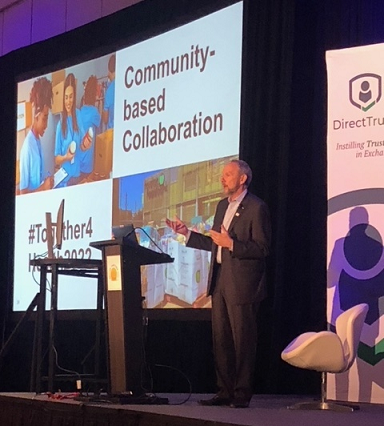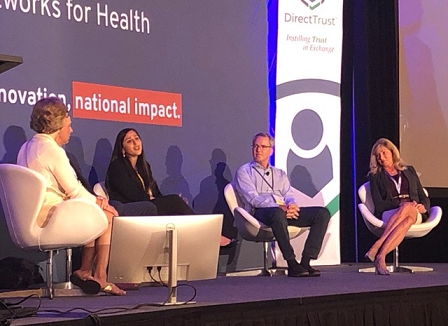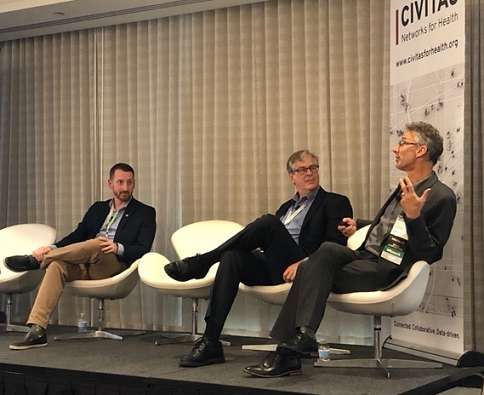At the last minute I had to cancel my trip to San Antonio for the Civitas and DirectTrust Better Together 2022 Conference. But Beth Friedman with our new media partner has stepped up and is reporting from the conference. Here are her notes and takeaways from Sunday and Monday, August 21-22.
Welcome Reception
Welcome from President and CEO of DirectTrust. Scott Stuewe
“All of us are in the health equity business, that’s why interoperability matters.”

Keynote - Rishi Manchanda, MD, MPH
Moving Upstream: How we can seize this moment to transform the social and structural drivers of health equity in our communities
Rishi Manchanda, MD, MPH, CEO, HealthBegins
Mission: Build America’s infrastructure for equity to counteract structures that harm people. To counteract structures that cause harm, we need infrastructure that promotes equity.
“Infrastructure for equity starts with data,” but many systems suffer from and perpetuate structural inequities: lack of race, ethnicity and language data for racialized groups effectively erases their existence.
- Algorithms don’t’ account for circumstances and concerns of marginalized communities
- Populations and communities have limited opportunities to inform or access actionable, place-based
Industry needs data sovereignty.
Defines “structural violence”:
- Many forms of structural violence including and how racism is a form of structural violence, how access to data (or lack of it) is structural violence.
- Teach a man to fish parable – but what if the person is a woman, what if there is no body of water nearby, what is the body of water is polluted and fish are unsafe to eat?
“Place” determines much. High need communities include 10% of US population, majority in the South. There are poor people of every race. But only poor people of color are systematically confined in poor places. Need: place-based, cross-sector strategies to promote health equity.
Accountable Communities for Health (ACH) – Value based programs have failed to advance health equity. There is lack of equity in policy design-perpetuate structural inequities and harm.
The HIEs stepped up during the pandemic. Generated concept of Health Data Utilities (HDUs) and many worked with public health to build a community-centered approach for data sharing.
#HealthEquity infrastructure starts with data. @RishiManchanda @HealthBegins #together4health2022 pic.twitter.com/pi1JLPahLp
— Civitas Networks for Health (@civitas4health) August 22, 2022
Bridging the Health Equity Divide with ADT Notifications
Panel:
- Lisa Nelson, MS, MBA. MaxMD
- Laura McCrary, EdD, KONZA
- Michael Cordeiro, Meditech
- Farah Saeed, eClinicalWorks
- Bill Howard, Audacious Inquiry, A PointClickCare Company
The focus was the ADT Notifications rule for providers. Panel discussed the new rule as a tool to:
- Turning “have to” into “want to”
- turning ADT requirements into an asset.
- Getting ADT notifications directly to the provider.
- The intervention trigger for reduced readmissions and better care outcomes
- Notification for all (not just the technology well-endowed)
- Right info to the right people at the right time
Most HIEs already have the technology in place to do this. Thinking forward for the specification for ADT real-time sharing:
- Meet all requirements from CMS
- Meet human-readable requirement
Now that you are already doing it, what is next? What are next steps?
Receiving systems – how do we improve utilization? Use and get excited about it? Easier, more accessible for users. Make it easy and useful.
- Route to a separate location
- Allow providers to search discreetly for specific document for each patient
- The when and where of sending an ADT is important, but also the “what” and “why”
Bill Howard: Watching error rates, down in the weeds work with data to ensure data integrity and accuracy. Data clean up. Look at whole process. Promising way to approach the problem. Shift to look at workflow, process. ADT alerting is useful for so many things. Public health, reducing readmissions, etc. There is a lot out there with the potential to improve health care through ADT alerting.
eClinical Works: This is the solution for a public health problem: for example, a state wants the HIE to deliver alerts with patients with specific issues, diagnosis, etc. Way to get information quickly to someone in the healthcare ecosystem. For example a state wants HIE to be able to notify providers when these patients get admitted into a hospital. Hospital wants alert for infectious disease team. Post acute care provider, hospitals, ambulatory practices, etc. It’s a win-win-win.

Lisa asks the panelists to pick their subtitle for the #ADTnotifications panel at #Together4Health2022. Mike from @MEDITECH picks 3, Farah from @eClinicalWorks picks 2, Bill Howard picks 4, and Laura from @KonzaHealth picks all of them because this is win for all @DirectTrustorg pic.twitter.com/ZzRFcpR4jj
— Kathryn Ayers Wickenhauser (@KAWickenhauser) August 22, 2022
Situational Awareness for Novel Epidemic Response (SANER) Project
Panel:
- George Gooch, CEO, Texas Health Services Authority
- Phil Beckett, HASA
- Lauren Knieser, Audacious Inquiry, A PointClickCare Company
- David Pyke, Audacious Inquiry, A PointClickCare Company

Developed an HL7 FHIR implementation guide to standardize reporting of bed availability, staffing availability, and equipment inventory.
SANER project in Texas – very rural, required in Texas by state authorities, urgent requirement in Texas during COVID to show a way to automate and standardize reporting, and Texas legislation mandated it.
George Gooch: “A silver lining of the pandemic that moves us forward on interoperability.”
Two pilot hospitals: Meet the hospital where they are (one on Epic, one on CPSI). HASA + THSA. Servers deployed at the HIE level. Pilot hospitals connect to servers. Servers adapt data to FHIR. Servers provide reporting back to SANER server.
Before project, it took 25 minutes per response for average public reporting requirement x 3 times a day, x all the TX hospitals. And reporting requirements were changing monthly during COVID. CMS is proposing to continue COVID-19 reporting requirements of patient impact and hospital capacity, staffing, and supplies.
SANER Project Vision:
Reduce manual reporting burden and cost on health care facilities and public health authorities. Create a common standard for hospitals. FHIR used as the standard. Data can be extracted automatically and in real-time from underlying data systems at both hospital and regional HIE level. Data can then be leveraged by multiple local, state and federal agencies for dashboards, reports and analytics. And data visualization can be customized for different users (aggregated for federal entities, line level data back to hospitals).
Current state of integration:
Still pilot project. Goal is for both hospitals to show reporting across these data standards and for these data elements. Within Texas, want entire state to consider using this for hospital reporting. It is a cooperative agreement so that other states can also use.
Something that can be extended to EMS providers for future disasters, especially for bed availability based on specific needs (ICU cardiac bed, etc.). The most probably use in Texas is for disaster response.
Future use cases to also see post-acute bed availability for hospital discharges/transfers. Attendee from Ohio mentioned that they were tracking post-acute beds manually during COVID.
 Beth Friedman, Senior Partner at FINN Partners
Beth Friedman, Senior Partner at FINN Partners
Beth’s professional experience includes work with hospitals, health systems, medical groups, health IT vendors, associations, and marketing agencies. She has experienced the healthcare industry from every aspect. And walked in many shoes.
Follow her on Twitter @HealthITPR
Connect with her on LinkedIn at Beth Friedman
